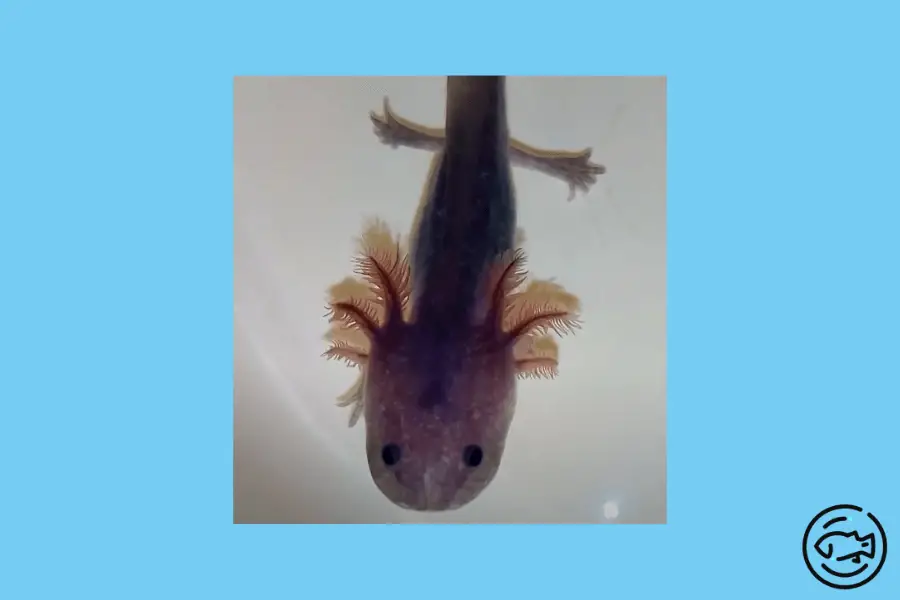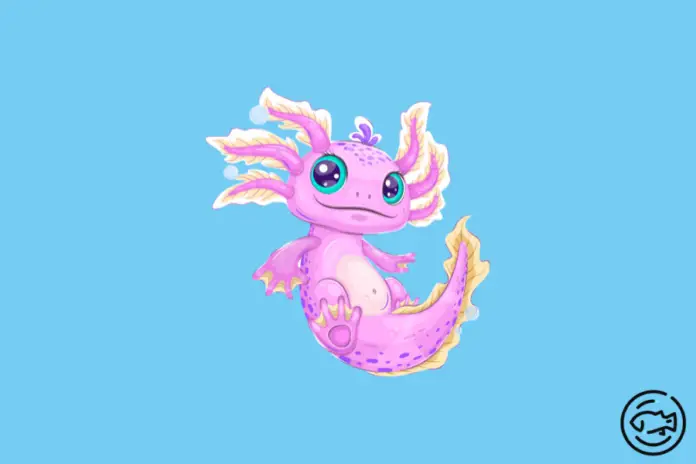Lavender axolotl is one of the most unique and fascinating species of the axolotl. They are easily recognizable by their beautiful lavender coloration and characteristics that set them apart from other axolotl species. They are calm and docile creatures that make great pets, and their beauty is sure to captivate any onlooker.
They are native to lake Xochimilco in Mexico and are listed as an endangered species. In the wild, they are estimated to survive for 10-15 years, but in captivity, they can live up to 18 years with proper care.
They are among the rearrest color morphs of the axolotl, and their coloration results from a unique pigment cell (chromatophores), giving them a silver dalmatian-like pattern.
They have been introduced to other countries, including the United States, but they are not as common in captivity as some of the other axolotl species.
You need to know and understand them if you intend to keep them as pets. Thankfully, we have helpful information about the care, habitat, diet, tank parameters, breeding, lifespan, and much more of the lavender axolotl.
Species Overview

Even though axolotls are salamanders, Lavender axolotls are a bit different in character and appearance due to their permanently aquatic lifestyle.
They do not develop on land like other salamanders but rather stay in their larval form (known as neoteny) their entire lives.
For this reason, they do not have lungs and must breathe through external gills on each side of their head. These gills are feathery and delicate, so they must be kept in clean water.
Lavender axolotls grow to be about 10-12 inches in length and can weigh up to 1.5 pounds. They have long and slender bodies with smooth skin covered in small bumps.
Their tail is long and finned, and they have four legs, each tipped with webbing. They have small eyes that sit on the top of their head and wide mouths filled with small, sharp teeth.
They have various color morphs, such as golden yellow, tanned or brown, greenish, black, albino, leucistic, and melanistic. But the most common and popular color morph is the lavender axolotl which has a light purple body with darker spots.
The pigment cells determine their coloration, and the color of their eyes can range from black to gold.
Three main types of pigment cell /chromatophores are found in axolotls which include xanthophores (yellow), iridophores (silver), and melanophores (black).
The distribution of these cells will determine the final coloration of the axolotl. For example, axolotls with a high concentration of xanthophores will be yellow, while those with a high concentration of melanophores will be black.
Lavender axolotls have a high concentration of both xanthophores and melanophores, which gives them their unique coloration.
Lavender axolotls are a non-aggressive species, making great pets for both experienced and beginner hobbyists.
They are a rugged species that is fairly easy to care for, and they are known to be very tolerant of changes in their environment.
Lifespan
Lavender axolotls are an expensive species, and finding one can be difficult. But if you are fortunate enough to find one, you will want to ensure that you take care of it properly so that it can live a long and healthy life.
These axolotls have a lifespan of 5-7 years in the wild because of their many dangers.
However, you will love to know that your pet lavender axolotl can live up to 18 years in captivity if provided with the proper care.
The mystery to your axolotl’s long and healthy life is maintaining a clean and stable environment and feeding it a nutritious diet.
Habitat and Tank Requirements
If you are lucky enough to hold this rare species of the axolotl, you must provide them with a suitable habitat that meets their needs so that they can thrive and live out their lives to the fullest.
These needs include proper tank size, water type, filtration system, and other accessories. Let’s take a peek at their needs in more detail so that you can provide your axolotl with the perfect home.
Tank Size
The minimum tank size for a single lavender axolotl is 15 gallons, but a 20-gallon tank is ideal.
If you plan to keep multiple axolotls, you must increase the tank size accordingly. For example, two axolotls will need a 30-gallon tank, and three will need a 40-gallon tank.
It is essential to observe that these are only the minimum tank requirements, and you should always opt for a larger tank if possible.
Decoration & Substrate
Lavender axolotls are fully aquatic creatures that spend their entire lives in the water. They do not require any land area or special decor in their tank, but you can add some rocks or driftwood if you wish.
It is important to use smooth rocks or driftwood in your tank so that your axolotl does not hurt itself. Add adequate hiding places for your axolotl to feel safe and secure.
As for the substrate, you can use either gravel or sand in your axolotl tank. If you use gravel, make sure that the pieces are small enough so that your axolotl does not accidentally ingest them.
Sand is a safer option, but it is essential to use quality aquarium sand so that it does not cloud the water.
Filtration
Setting up an effective filtration system is one of the most critical aspects of axolotl care.
This is because axolotls produce a lot of waste, and a good filtration system will help to keep the water clean and safe for your axolotl.
Ensure that there are no strong currents in the tank, as axolotls are not strong swimmers and can easily be swept away by a strong current.
Water Parameters
Maintaining the proper water parameters in your axolotl tank is crucial to stay healthy and thriving.
You should change the water in your axolotl tank regularly, and the frequency will depend on the size of your tank and the number of axolotls you have.
Generally, you should change 20-30% of the water each week.
The ideal water temperature for axolotls is 60-65°F, and the pH should be between 7 and 7.8.
You can use a water conditioner to remove harmful chemicals from the water, and you should also consider using an aquarium heater to maintain the proper water temperature.
Lighting
Lavender axolotls do not require special lighting, but you can provide a low-light environment by using an aquarium hood with fluorescent light.
This is not required, but it can help to make your axolotl’s tank look more natural. As nocturnal creatures, they are adapted to low-light environments, so they will not be harmed by dim lighting.
Breeding
Taking the proper steps in breeding dalmatian axolotls is essential to hatch and raise healthy young successfully.
They usually reach sexual maturation when they are around 6 to 12 months old, although some axolotls can take up to 18 months to reach sexual maturity.
They do a dance-like courtship ritual before breeding, and the female will lay her eggs in a safe location, such as under a rock or in some plants.
The female axolotl can lay up to 100 eggs simultaneously, but the average clutch size is around 200 eggs. The eggs take approximately two weeks to hatch, and the larvae will undergo a metamorphosis into juvenile axolotls after about 6-8 weeks.
In the wild, they typically breed in spring when the water temperature rises, but they can produce year-round in captivity.
Food and Diet
Lavender axolotls are carnivores, meaning their diet consists mainly of meat. Their diet comprises small insects, worms, and other small aquatic creatures in the wild.
In captivity, you can feed your axolotl live food, frozen food, or pellets. It is essential to offer a variety of foods to ensure that your axolotl is getting the nutrients it needs.
Live food is the best option for axolotls, as it is their most natural and nutritious diet. Live food includes worms, small insects and other aquatic creatures.
If you choose to feed your axolotl live food, it is essential to source it from a reputable supplier to ensure it is safe and free of parasites.
Frozen food is the next best option and is widely available from pet stores. Frozen food is usually less expensive than live food and is a convenient option for busy axolotl owners.
Care Tips to Keep Your Axolotl Healthy
Pet lavender Axolotls are a relatively delicate species, so it’s important to take special care to keep them healthy.
Here are a few essential tips to assist you in taking care of your axolotl:
- Do not hold or handle your axolotl with your bare hands, as their skin is very sensitive and can easily be damaged. Use a net or gloves when handling them.
- Keep the water in their tank clean and well-filtered, as they are sensitive to water quality. Change the aquarium water frequently and vacuum the gravel to remove any debris.
- Feed your axolotl a variety of living, frozen, and pellets to ensure they get the nutrients they need.
- Do not breed them before they are 18 months old, as they need to be fully matured before breeding.
- Inspect their skin regularly for any signs of irritation, injury, or unusual behavior, and take them to the vet if you are concerned about their health.
- Have a backup plan in place in case of power outages or other emergencies, as they are sensitive to temperature and water quality changes.
Conclusion
Lavender axolotls make great pets for experienced aquarists, as they are relatively low-maintenance and easy to care for. They are a delicate species, so it’s important to take special care to keep them healthy.
Keep their tank clean, offer a variety of foods, and do not handle them with your bare hands. Though they are rare and expensive, they are worth the investment if you are looking for a unique and interesting pet.




[…] also read: Lavender Axolotl – Care, Lifespan, Diet & More! […]
[…] ALSO READ: Picasso Clownfish – Everything You Need To Know! […]